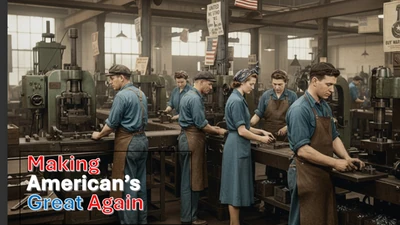Understanding Average Returns for Low, Medium, and High-Risk Investments: A Guide for Conservative Investors
As President Trump’s economic policies reshape markets in Q2 2025, conservative investors are seeking stable, reliable opportunities to grow their wealth while minimizing risk. Trump’s America First agenda—emphasizing domestic production, deregulation, and strategic tariffs—has created a dynamic but volatile market environment, with the S&P 500 down 7.9% since his January 20 inauguration. For conservative investors, understanding the average returns of low, medium, and high-risk investments is crucial to balancing growth with security. This article breaks down these categories, providing historical and projected returns, and offers insights tailored to a conservative mindset focused on preserving capital while supporting Trump’s vision of a resurgent American economy.
Low-Risk Investments: Stability First
Conservative investors prioritize capital preservation, making low-risk investments the cornerstone of their portfolios. These options offer predictable returns with minimal volatility, aligning with a cautious approach.
- Treasury Securities: U.S. Treasury bills, notes, and bonds are backed by the federal government, making them virtually risk-free. As of April 2025, 10-year Treasury yields are around 4.22%, reflecting a flight to safety amid tariff-driven uncertainty. Historical annualized returns for 10-year Treasuries have averaged 2-3% over inflation from 1926 to 2023 (per Ibbotson Associates data). For 2025, with inflation projected at 2.5% (Federal Reserve estimates), expect real returns of 1.5-2%.
- High-Yield Savings Accounts and CDs: These offer guaranteed returns with FDIC insurance up to $250,000. In April 2025, top high-yield savings accounts yield 4.5-5%, and 1-year CDs offer 4.75-5.25% (based on recent Bankrate data). Historical returns for savings accounts have averaged 0.5-1% above inflation, but current rates provide real returns of 2-2.5% after inflation.
- Dividend Aristocrats: Stocks of companies with 25+ years of consecutive dividend increases (e.g., Procter & Gamble, Johnson & Johnson) offer low risk with steady income. These stocks have historically returned 6-8% annually (including dividends) from 1990 to 2023, with volatility half that of the broader S&P 500. In 2025, expect 5-7% returns, factoring in market turbulence.
Conservative Takeaway: Low-risk investments provide 1.5-7% annual returns, with real returns (after inflation) of 1-4.5%. These are ideal for parking 40-50% of your portfolio, ensuring stability while Trump’s trade negotiations unfold.
Medium-Risk Investments: Balancing Growth and Safety
Medium-risk investments offer higher returns than low-risk options but come with moderate volatility. They suit conservative investors willing to take calculated risks for growth, especially in sectors benefiting from Trump’s policies.
- Corporate Bonds (Investment-Grade): Bonds from financially stable companies (rated BBB or higher by S&P) offer moderate risk. In April 2025, yields on investment-grade corporate bonds average 5.5-6%, up from 4.5% in 2024 due to inflation fears (Moody’s data). Historical returns from 1980 to 2023 averaged 5-7% annually, with real returns of 2-4%. Expect 2025 returns of 5-6%, with real returns of 2.5-3.5%.
- Blue-Chip Stocks: Large-cap companies like Walmart or ExxonMobil provide growth with less volatility than the broader market. Historically, blue-chip stocks have returned 8-10% annually (1990-2023), with dividends contributing 2-3%. In 2025, with Trump’s energy and retail sectors gaining from deregulation, expect 7-9% returns, or 4.5-6.5% after inflation.
- Real Estate Investment Trusts (REITs): REITs (e.g., Vanguard Real Estate ETF) offer exposure to real estate with liquidity. Historical returns from 1972 to 2023 averaged 9-11% annually, including dividends (Nareit data). With commercial real estate rebounding under Trump’s domestic focus, 2025 returns may hit 8-10%, or 5.5-7.5% after inflation.
Conservative Takeaway: Medium-risk investments yield 5-10% annually, with real returns of 2.5-7.5%. Allocate 30-40% of your portfolio here, focusing on sectors like energy and real estate that align with Trump’s policies, while diversifying to mitigate tariff-related risks.
High-Risk Investments: Proceed with Caution
High-risk investments offer the potential for significant gains but come with substantial volatility, which can be unsettling for conservative investors. These are best approached sparingly, with a focus on long-term growth.
- Small-Cap Stocks: Small-cap stocks (e.g., Russell 2000) benefit from Trump’s deregulation and tax reform promises, surging 8.66% after the tariff pause. Historically, small-caps have returned 10-12% annually (1926-2023, per Ibbotson), but with 50% higher volatility than large-caps. In 2025, expect 9-11% returns, or 6.5-8.5% after inflation, though tariff uncertainty could lead to sharp swings.
- Emerging Market Equities: These markets (e.g., MSCI Emerging Markets Index) offer growth but are sensitive to global trade disruptions. Historical returns from 1988 to 2023 averaged 9-11%, with high volatility (standard deviation of 20%). Trump’s 125% tariffs on China in 2025 may dampen returns to 7-9%, or 4.5-6.5% after inflation, as trade tensions hit markets like China and India.
- Sector-Specific ETFs (e.g., Technology): Tech ETFs (e.g., Technology Select Sector SPDR Fund) have been hit hard by supply chain concerns, with the Nasdaq down significantly in Q1 2025. Historical returns from 1990 to 2023 averaged 12-15%, but 2025 projections are 8-10% (5.5-7.5% real) due to tariff impacts on companies like Apple and Nvidia.
Conservative Takeaway: High-risk investments can return 7-11% in 2025, with real returns of 4.5-8.5%. Limit exposure to 10-15% of your portfolio, focusing on small-caps benefiting from domestic growth, and avoid overexposure to tariff-sensitive sectors like tech or emerging markets.
Historical Context and 2025 Projections
To provide context, here’s a summary of historical and projected returns for conservative investors:
Risk Level | Historical Annual Return (1926-2023) | 2025 Projected Return | 2025 Real Return (After 2.5% Inflation) |
Low | 2-8% (Treasuries, Dividend Aristocrats) | 1.5-7% | 1-4.5% |
Medium | 5-11% (Corporate Bonds, Blue-Chips, REITs) | 5-10% | 2.5-7.5% |
High | 9-15% (Small-Caps, Emerging Markets, Tech) | 7-11% | 4.5-8.5% |
Historical data draws from sources like Ibbotson Associates, Nareit, and MSCI, adjusted for 2025 conditions based on current market trends, Federal Reserve projections, and Trump’s policy impacts.
Strategic Considerations for Conservative Investors
- Prioritize Low-Risk Core: Allocate 40-50% to Treasuries, CDs, and dividend aristocrats to weather market volatility. For example, a $100,000 portfolio could hold $40,000 in low-risk assets, yielding $600-$2,800 annually.
- Selective Medium-Risk Growth: Invest 30-40% in blue-chip stocks and REITs, focusing on sectors like energy and financials that benefit from Trump’s deregulation. This could add $1,500-$4,000 in returns on a $35,000 allocation.
- Cautious High-Risk Exposure: Limit high-risk investments to 10-15%, focusing on small-caps (e.g., Russell 2000 ETF). A $15,000 allocation might yield $1,050-$1,650 but requires monitoring for tariff-related dips.
- Monitor Inflation and Fed Policy: With inflation at 2.5% and potential Fed rate cuts in 2025, low-risk yields may decline. Shift toward dividend stocks or REITs if Treasury yields drop below 4%.
- Stay Diversified: Trump’s tariffs and trade negotiations create uncertainty. Diversify across asset classes to mitigate sector-specific risks, such as tech’s supply chain challenges.
Conclusion
For conservative investors in April 2025, understanding the risk-return spectrum is key to navigating Trump’s evolving economy. Low-risk investments (1.5-7% returns) provide a safety net, medium-risk options (5-10%) offer balanced growth, and high-risk investments (7-11%) can enhance returns if approached cautiously. By prioritizing stability, focusing on domestic sectors, and keeping a close eye on policy developments—like the July tariff pause expiration—conservative investors can build a portfolio that supports Trump’s vision while safeguarding their financial future.
Disclaimer: This article is for informational purposes only and not financial advice. Consult a financial advisor before making investment decisions.










